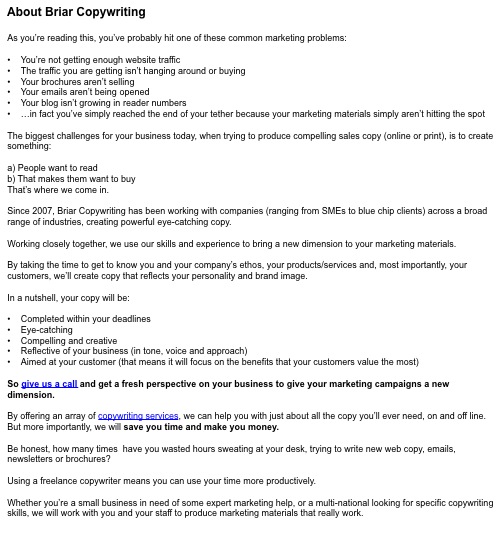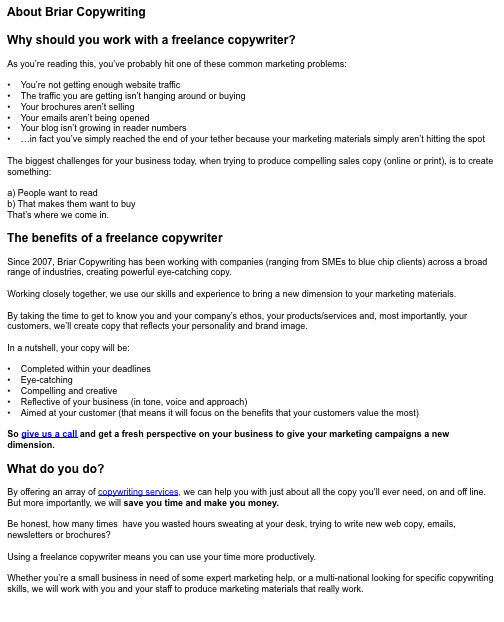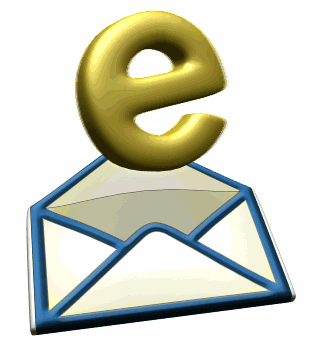Entries from December 2012 ↓
December 19th, 2012 — Google, Google search, seo
Online marketing is a very competitive world.
Everyone wants to be on the front page of the search results, but rather than working hard and building a solid base of informative, relevant content and good links, some marketers still try to find short cuts.
However tempting it may be, there is no substitute for hard work because if you do try to cut corners you will incur the wrath of Google.
So what sort of activities are we talking about?
There are quite a few, but for this particular post we shall concentrate on 7.
1. Cloaking
Nope, it’s not something out of Star Trek.
Cloaking means you’re showing the search engines one thing and your visitors something else. So you could be promoting a site for an activity such as fell walking in the search results, but when someone clicks on the link, they’re taken to a pornographic site.
A very deceptive practice, which is completely forbidden by Google.
2. Duplicate content
Yes, unbelievably this still happens. People attempt to boost their page views by creating many pages with the same content.
If you inadvertently duplicate content on your own site through the use of categories, tags or archived pages, you’ll be OK although it could still get you penalised.
3. Scraping content
Everyone knows that good rankings come from the creation of great content. But for those who really can’t be bothered and think it’s OK to scrape content from other sites, tweak it a bit and then publish it, Google is watching you and will come down on you like a tonne of bricks.
4. Unrelated keywords
The only keywords that should be used for your site are those that are actually related to the content in your site. It really isn’t rocket science.
Of course, stuffing your keywords (related or otherwise) is also a huge no-no, but you knew that, right?
5. Link exchanges
The best way to develop your links is to do it carefully, manually and with integrity. If you pay for links you’ll get banned; if you link back to everyone who links to you, you could damage your reputation.
Basically, Google will check out your external links and incoming links for the quality of the linking sites. If they have a low reputation it will have an effect on you – so be careful.
6. Hidden keywords
The below will get you de-indexed or penalised:
- Plastering your site with keywords in the same colour as your background
- Keywords in really, really tiny font size at the end of your site
Guess what? They show up in your code so it really doesn’t take much for Google to spot it.
7. Stacking your titles
There’s a simple rule to follow: one headline per page.
Writing more than one and stuffing them with your keywords will hack Google off. Do it properly and make the most of your heading my placing your important keywords at the start of headline, making the most of the 70 characters available to create one that is meaningful.
Over to you
The 7 scenarios above are just the tip of the iceberg when it comes to getting yourself de-indexed by Google.
Can you think of any more?
If so, write a comment below and let’s see how many we can find.
Sally Ormond – professional copywriter, founder and MD of Briar Copywriting Ltd
December 17th, 2012 — Content writer, copywriter, copywriting, copywriting tips
Content rules the Internet and considering most of that is in the form of words, that’s a lot of reading.
You all know that reading from a screen is more difficult than reading from books or magazines. That’s not to say that your intellect suddenly falls several points when faced with a computer screen, but rather reading from a back-lit screen can be rather tiring on your eyes, which leads to less concentration.
That’s why its important to use sub headings – a feature used by every professional copywriter you’ll come across – because they make it easier for readers to read.
The best way to show you the effect sub headings have is through an actual illustration. Below is a sample of copy taken from by About Us page – first of all without any sub headings:

As you can see, even with the paragraphs intact the piece doesn’t really make you want to read. The text looks too dense and there is no direction as to what information the page contains.
Now let’s look at it again with the sub headings in place:

This time there is much more structure to the page. The sub headings act as signposts telling the reader what information the page contains making it easier for them to navigate to the section they want to read.
The aesthetics of sub headings
Aesthetically, the page looks more inviting with sub headings: a solid wall of text gives the impression that the subject matter is going to be difficult to read and boring, so it won’t encourage people to give up their valuable time to read it.
With sub headings the reader can break the page down:
- The sub headings act as rest points; the reader can break of at any time and not lose their place.
- They can glance down the page and pick out the information they need
- They give the impression of an ‘easy read’, which subconsciously suggests the information will be easy to grasp
So you see, just the simple inclusion of sub headings in your writing can boosts its readability.
Next time you’re writing website copy, brochures, blogs or articles, pay special attention to how you lay the information out. Use sub headings and short paragraphs to make it easy to follow and understand, that way you’ll boost your engagement with your readers.
December 14th, 2012 — briefing a copywriter, copywriter, copywriting tips
Anyone who has hired a professional copywriter to help with their sales and marketing materials will understand the collaborative process that lies behind a successful relationship.
Once you’ve briefed your copywriter and told them all they need to know, they’ll go away and create a first draft.
So what do you do when that first draft pops up in your inbox?
Reviewing the copy should be done in three separate steps.
Here’s the first.
1. Get to know it
First of all you have to get to know the copy. That means reading in through to get a sense for the writing.
Reading it out loud is a great way to get to grips with it. As you go through it, make a note of any places where your attention slips, or areas that you find confusing, or that simply don’t seem to flow well.
Once you’ve done that, you’re ready for step two.
2. Soft edit
A soft edit solely looks at the spelling, punctuation and grammar. In theory, as you’re using a copywriter, there shouldn’t be too much to do here, but typos can be notoriously hard to spot, so one or two may slip through.
Once that’s done, you’re ready for the final step.
3. Hard edit
This is where you need to look at the content itself and highlight areas that may be incorrect or where information should be expanded.
In theory, your brief should have been comprehensive enough for your copywriter to add all the detail required, but sometimes things get missed.
This is the point where you have to place your trust in your writer’s abilities and trust their professional instincts, which have been honed over many years.
Put your feelings aside and forget about how you would have written it – that means word choice, sentence structure and use of rhetorical devices.
If you just wade in changing things willy-nilly because ‘you would have written it differently’, you might as well have just written it yourself.
You hired a copywriter because:
- You don’t have time to do it
- The materials you were using simply weren’t working
- You don’t have the necessary skills to produce great copy
They’re not going to write like you; they’re going to write like a professional writer who has a lot of experience in what they do – so trust them.
December 12th, 2012 — copywriting tips, effective copy, email copywriting
There are loads of articles on the Internet telling you how to get the most from your email marketing, but what about the emails you send to clients and colleagues every day?
You may think that because they have nothing to do with direct selling the way you write them is not that important.
Really?
How many times have you sent an email to someone with a request that never gets answered? Or how about one that asked several questions and you ended up sending numerous other emails because the recipient didn’t answer everything first time round?
The way you write your daily emails will have an impact on your efficiency.
You might think that’s an odd thing for a marketing copywriter to be writing about. But everything you write in your business has to be persuasive enough for someone to take an action – even if that is just to open your email and read it.
Email subject lines
The subject line is always a good place to start.
Let’s face it, we are all inundated with emails every day and have to make quick decisions about which ones get our attention first.
Those that have subject lines such as:
- Hello
- FYI
- It’s been a while
- 2013 Report on the risk analysis of the environment impact….
Are unlikely to grab you as emails that have to be opened, read and actioned immediately.
But if you start it with something like:
- We need your decision today
- Please reply yes or no
- Your feedback is needed for today’s meeting
It’s more likely grab the recipient’s attention.
Call to action
The staple requirement for all copywriting projects, calls to action are also necessary in your emails.
But don’t leave them to the end – if you want someone to act quickly, tell them straight away. It’s important they read and action your email, so the first sentence should tell them that.
If you leave it to the end, you run the risk of them getting bored and moving on to a different email or having a sneaky game of Solitaire.
To chase or not to chase
Of course it’s OK to chase an email if you’ve not had a response, but not within a couple of hours of sending it.
Come on, be realistic – not everyone checks their emails every 5 minutes. If they did they’d never get anything else done.
If you need a speedy reply and you’ve not heard from them within a couple of days, fine, send a polite chaser or call them.
One subject
It’s very tempting to send one very long email covering everything you want someone to do.
The problem is, your email will come across as garbled, rambling and downright confusing.
By covering one topic at a time, everyone will know where they stand and things won’t get missed.
Be brief
This one is related the one above.
Trying to cover too much in one email will just lead to confusion. Keep your message brief and to the point; why not use bullets and numbered points to help the recipient keep track of what’s required – it will also make it easier to respond to.
None of this is ground breaking stuff, but every now and then we need reminding.
How you communicate with others will not only have an effect on them, it will also impact on your own efficiency and productivity.
Make sure your messages are clear and to the point – and if it’s something that can’t easily be explained via email, rather than trying, pick up the phone.
December 10th, 2012 — Google search, search engine optimisation, seo, SEO copywriter, seo website copywriter
Everyone understands the importance of search engine optimisation.
But not everyone seems to grasp the fact that it’s an ever-changing field of marketing. As search evolves so do the complex algorithms the search engines use to determine which sites are relevant to which search terms.
Why the constant changes?
That’s mainly down to the less than white SEO ‘experts’ out there who find a technique to boost their website’s rankings and exploit it.
For example, as a result of websites with poor content that wasn’t relevant, Google’s Panda came along. Hot on its heels was the mighty Penguin to battle against keyword stuffers, cloaking, duplicate content and those participating in link schemes.
In the world of SEO you have two choices: keep doing what you’ve been doing for years and watch your website disappear from view; or move with the times and adopt new techniques.
SEO Techniques to steer clear from
To get you on the right path, here are just a few old SEO techniques that should be consigned to the rubbish bin.
1. Keyword density
This is a phrase that should never be mentioned again.
If you’re not sure what it is, it’s a dreadful practice old SEOers once employed, claiming you have to have a certain percentage of keywords in your website copy in order get ranked for that particular search term.
Wrong.
If it were that simple, the world would be full of websites that were complete gibberish and only contained one or two phrases repeated again and again.
The right way to create effect SEO copywriting is by writing high quality content that is written naturally.
2. Numerous press releases
Online press release outlets were seen as a God send to many.
The result was numerous press releases that had absolutely no substance to them whatsoever being blasted across the web in the hope of attracting a back link or two.
The main problem with this is that you’re putting out substandard releases for the general public to see, which is hardly going to put your company in a good light.
There’s nothing wrong with issuing press releases, but only when you actually have some news to tell.
3. Content spinning
Once upon a time, marketers would write an article, spin it using some software and post it out to numerous websites. Worse still, they would send out the same article to hundreds of websites creating vast swathes of duplicate content.
That is such a bad idea.
If you want to put content out there make sure it’s original, of high quality and offers the reader something. After all, if you want to generate links, it has to be some pretty awesome content.
4. Meta tags
Once upon a time (there’s a pattern forming here) SEO was linked to your meta tags because they helped the search engines determine the relevance of your website. Surprise, surprise, this resulted in numerous SEOers stuffing their meta tags (they appear in the <head> section of your website’s code) with keywords.
The search engines are far cannier these days, and use other tags (e.g. title tags and alt tags) and the actual content of your website to determine what your web page is about.
As you can see, throughout the history of SEO someone finds a loophole and exploits it. That’s why it’s important you keep updated with the latest SEO techniques and news to make sure your efforts continue to bring you the results you want.










